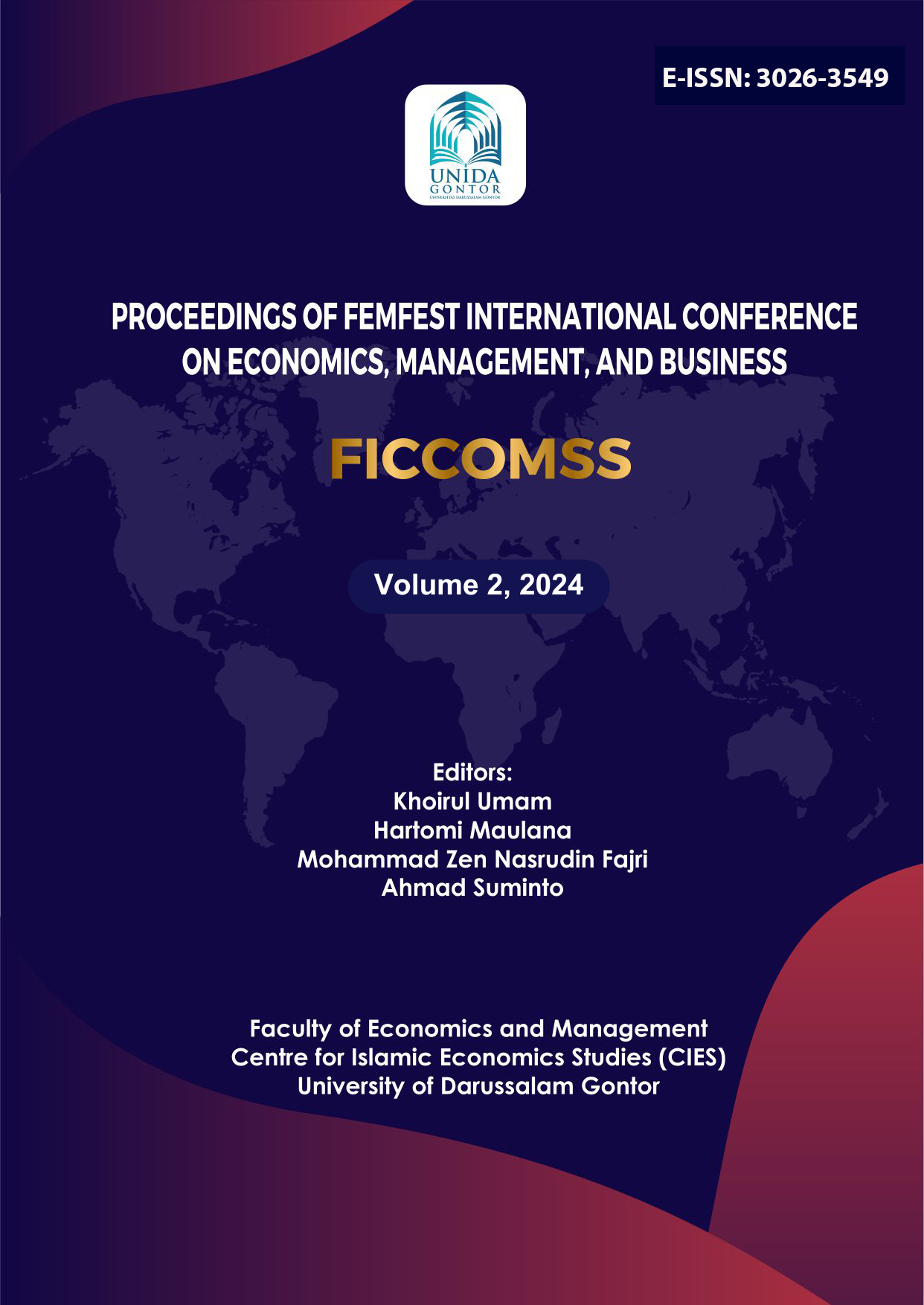A Qualitative Assessment of Islamic Social Finance and Village Funds on the Poverty Level during the Covid-19 Pandemic
Abstract
This study aims to examine the role of Islamic social finance funds i.e. Zakat, Infaq, Shadaqah, Waqf, and village funds on the poor’s financial viability during the Covid-19 pandemic. The study employs a qualitative method. Data collection in this study was obtained from field observations and in-depth interviews with informants. The informants were classified into three categories: government representatives, Islamic social finance experts, and the recipients of funds in Bogor Regency. This research uses Miles & Huberman's qualitative data analysis technique. This study shows that Islamic social funds and village funds impact the poverty level of the poor impartially. However, Islamic social finance and village funds could assist the poor’s financial viability and provide capital for business during the pandemic. To have an impactful program, the experts suggested an integrated scheme of institutional collaboration and community consolidation.References
Al-Haritsi, J. (2015). Fikih Ekonomi Umar Bin al-Khathab. Jakarta: Pustaka Al-Kautsar.
Arief, S., Azizah, I. N., & Nurfattah, A. (2024). Cash Waqaf as Guarantee of Social Economic Prosperity. Iqtishodiyah: Jurnal Ekonomi dan Bisnis Islam, 10(1), 176-190.
BAZNAS, P. K. (2021). Outlook Zakat Indonesia 2021. Jakarta: Pusat Kajian Strategis BAZNAS.
Beik, D. I. (2020). Introduction to Islamic Social Finance. IIIT Online Classes.
Bhandari, R. (2020). Coronavirus Recession a Short Review. IOSR Journal of Economics and Finance, Vol. 11 No. 3, pp. 15-17, doi: 10.9790/5933-1103011517.
Blake, H. B. (2020). Mitigating the Psychological Impact of COVID-19 on Healthcare Workers: a Digital Learning Package. International Journal of Environmental Research and Public Health, Vol. 17 No. 9, pp. 1-15, doi: 10.3390/ijerph17092997.
Bogor, P. R. (2021). Ade Yasin: Perekonomian Kabupaten Bogor Membaik. Retrieved 2 2, 2022, from www.bogorkab.go.id: https://bogorkab.go.id/post/detail/ade-yasin-perekonomian-kabupaten-bogor-membaik
BPS. (2022). Profil Kemiskinan di Indonesia September 2021. Jakarta: Badan Pusat Statistik.
BPS, B. (2021). Ekonomi Indonesia Tumbuh 3,51 Persen. Retrieved February 1, 2022, from Ekonomi Indonesia Tumbuh 3,51 Persen: https://www.bps.go.id/news/2021/11/05/435/ekonomi-indonesia-tumbuh-3-51-persen.html
BPS, B. P. (2021). Persentase Penduduk Miskin (Persen), 2018-2020. Retrieved February 9, 2022, from Persentase Penduduk Miskin: http://www.bogorkab.bps.go.id
Covid-19, G. T. (2022, january monday). Situasi Virus COVID-19 di indonesia. Retrieved january monday, 2022, from www.covid19.go.id: https://covid19.go.id/
Demir, E. B. (2020). The relationship between Cryptocurrencies and COVID-19 Pandemic. Eurasian Economic Review, Vol. 10 No. 3, pp. 349-360, doi: 10.1007/s40822-020-00154-1.
djpb.kemenkeu. (2020, January 1). Dana Desa: Pengertian, Sumber Dana, Penyaluran Dana, dan Prioritasnya. Retrieved April 6, 2022, from Dana Desa: Pengertian, Sumber Dana, Penyaluran Dana, dan Prioritasnya: https://www.pengadaan.web.id/2020/01/dana-desa-adalah.html
Indonesia, K. K. (2021). Merekam Pandemi Covid-19 dan Memahami Kerja Keras Pengawal APBN. Jakarta: Kementrian Keuangan Republik Indonesia.
Indonesia, K. S. (2020, October 22). Siaran Pers. Retrieved January 1, 2022, from Mentri Sosial: https://kemensos.go.id/upaya-pengentasan-kemiskinan-mensos-perlu-ada-kesetaraan-gender
izzati, R. A. (2021, july 26). Indonesia’s Poverty Situation during the COVID-19 Pandemic. Retrieved 2 1, 2022, from smeru research institute: https://smeru.or.id/en/content/indonesia%E2%80%99s-poverty-situation-during-covid-19-pandemic
Jackson, J. W. (2020). Global Economic Effects of COVID-19. Congressional Research Service, R46270â€, available at: https://crsreports.congress.
Miles, M., & Huberman, A. (1994). Analisis Data Kualitatif. Jakarta: Universitas Indonesia Press.
Moleong, L. J. (2018). Metodologi penelitian kualitatif / penulis, Prof. DR. Lexy J. Moleong, M.A. Bandung: PT Remaja Rosdakarya.
Murobbi, M. N., & Usman, H. (2021). Pengaruh Zakat, Infak Sedekah, dan Inflasi terhadap Kemiskinan di Indonesia. Jurnal Ekonomi & Ekonomi Syariah, Vol 4 No 2.
Nurfattah, A., & Bachtiar, R. (2023). Optimizing Waqf Management for Social Impact. Islamic Business and Management Journal, 6(2), 120-131.
Relief, I. (2018). Islamic Social Finance. Retrieved April 11, 2022, from What you need to know about Islamic social finance: https://www.islamic-relief.org/islamic-social-finance/
Rofiqo, A., Suminto, A., Sari, D. N., & Ramadhan, M. A. (2022). Factors that Influence of Behavior to Contribution in Islamic Peer-to-Peer Lending with PLS-SEM Approach: Empirical Studies in Indonesia. 8, 66–84.
Sekaran, U., & Bougie, R. (2016). Research Methods for Business : A Skill-Building Approach / Uma. West Sussex: John Wiley & Sons Ltd.
Sigit, T. A., & Kosasih, A. (2020). Pengaruh Dana Desa Terhadap Kemiskinan: Studi Tingkat Kabupaten/Kota di Indonesia. Jurnal Perbendaharaan, Keuangan Negara dan Kebijakan Publik, Vol.5, No. 2 Hal.105-119.
Suliswanto, M. S. (2010). Pengaruh Produk Domestik Bruto (PDB) dan Indeks Pembangunan Manusia (IPM) Terhadap Kemiskinan. Jurnal Ekonomi Pembangunan, Vol 8 No. 2 .
Todaro, M. (1997). Pembangunan Ekonomi di Dunia Ketiga Edisi Keenam, Edisi Terjemahan. Jakarta: Penerbit Erlangga.






